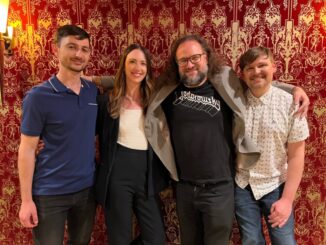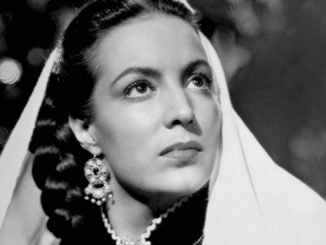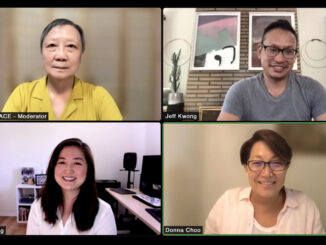
Where are you currently employed?
NBC – from the comfort of my basement workstation.
Current projects?
I’m finishing a fun pilot called “Connecting.” It’s a Zoom-style half-hour comedy for NBC. The most notable and unique aspect of this project is that everyone is working remotely, including the actors! With guidance from the director, DP, and crew, they set up and film themselves. Pre-COVID, I couldn’t have imagined I’d ever be working in such a way. It’s made me realize the world of post-production is possibly a more social place than it gets credit for.
Other current projects include:
Trying to ignore the things around the house that need fixing — that was so three months ago. I need a break.
Homeschooling two kids, 5th and 6th grade, which I find inevitably leads to a cocktail hour. When did math change?
Describe your job.
My job is tremendous fun. I love and enjoy stories. I believe picture editors have a unique position — we get to be a little bit of everything: writers, as we trim or reorder scenes; directors, as we evaluate performances and create an even tonal arc for the characters; and DPs, as we pore over the images and select those that best convey the desired emotion. Editing is a collaborative effort that, when done well, is a magical experience.
How did you first become interested in this line of work?
When I was in high school, my father, Professor Stephen Murray, who had started the Media Center for Art History at Columbia University, brought home a Hi8 camcorder. I was quickly attracted to what it could enable me to do. With that camera, I made my first stop-motion animation, which would go on to win a Tri-State art show adjudicated by Robert Storr, the curator of painting and sculpture at the Museum of Modern Art (MoMA). As with most people making their own projects, I had to do most everything, including editing.
Who gave you your first break?
I think that my parents, Grainne and Stephen, probably qualify as giving me my first break… right?
As far as my break as an editor, there is one person who immediately comes to mind: Sean Backus. After a couple of years of trying to support myself in a half-baked career as a semi-professional motorcycle racer, I moved to Los Angeles with about $750 to my name. Although I’d learned how to run an Avid at NYU, most of the work I could find was short format or industrial material that was cut on Final Cut Pro. I cold-called every post house and chased down every internet job posting. That was pretty grim. When I was lucky enough to get called in for an interview, I had a front row seat to watching the interview end the moment I mentioned it had been a while since I worked on an Avid. After three weeks of calling a company on the advice that “they’re always looking for editors,” I finally got an interview with Sean.
If I was going to make this professional editor thing work, I had to make a change in my interview strategy. After the ritual opening pleasantries, sure enough the Avid question came up. This time I knew just what to do: “Of course I know Avid, like the back of my hand,” which was followed by “Of course I can start on Monday.” This was on a Friday. On the way home, feeling a mixture of excitement and terror, I stopped at Samuel French’s book store (too bad it’s no longer around), got Sam Kauffman’s Intermediate editing handbook, and then locked myself in a room for two days to consume the material. The job involved cutting show segments for a HGTV show, and I was extremely lucky it was a night gig; that way, no one could see me struggle to make a simple edit or know how many hours I’d spent there. In short order, I got to know Avid like the back of my hand — and here I am 15 years later, still getting paid to do this. Thank you, Sean.
My first union break came from Thomas Bolger, the cousin of my good friend Francis. Thomas was kind enough to take me out to lunch when I first got to LA, and he gave me the sage advice to get my ducks in a row and join the union. Over the next year or two as I cut short-format and reality-based material, I slowly accumulated the necessary hours and documentation required to join the Guild. Occasionally, I would check in with Thomas to ask for advice or to let him know what I was cutting. One day, he called to tell me that “Rescue Me” needed an assistant to fill in for a bit – and that was my ticket. I paid my initiation fee and was on my way… except for one small problem: I’d never assisted. Thomas was there to help walk me through the technical aspects of the job, for which I’m eternally grateful.
What was your first union job?
“Rescue Me” was my first union gig. It was a great place with great people. Leslie Tolan was the supervising editor, and I was lucky enough to be the assistant tasked with prepping drives to send her as well as “tech-ing” her system. It was a great opportunity to talk with her. She was generous with her advice and time. I would practice cutting scenes and she would watch them and give feedback. Leslie and Dauri Chase gave me my first episode to cut, which turned out well, and that led to cutting two more episodes that season. The experience was thrilling. I got to cut the series’ penultimate episode, which wound up getting nominated for a Hollywood Professional Association (HPA) award for “Outstanding Television Editing.” I was told that getting your second credit is more difficult … and that was true. I worked every angle I had, but it turns out not too many people want to risk hiring someone with three episodes and a whole bunch of shorts on their CV. I remember contemplating that if I was fortunate to win the HPA award, would it be poor form to solicit the audience for editing opportunities?
What credits or projects are you proudest of, and why?
The opening sequence to the pilot “Blindspot” is something that I’m pretty proud of. The scope was massive. They shut down Times Square to shoot it, the story is intriguing, and the images are arresting. The opening sequence is about three minutes long with only a few lines of dialogue. I’m proud of it mostly because, with the exception of it getting a little shorter, it didn’t change from the way I’d originally envisioned it.
What was your biggest challenge in your job (or on a particular project) and how did you overcome/solve it?
I think the biggest challenge can be respecting a healthy work/life balance. I’m thankful for my wife, Emily, who helped me with this. Work can be consuming, and I do feel that you should always bring your best to every aspect of a job. But as my grandmother frequently said, “You’ll be a long time dead.” That quote didn’t make much sense to me when I was five, but it makes a great deal of sense now.
What was the most fun you’ve had at work?
For the pilot of “The Enemy Within,” I had to cut and lock a massive VFX sequence and explosion for the show’s opening. That would not typically be a big deal, but on this occasion, it had to happen on the same day I got the dailies for the sequence. It was intense and there was a lot of energy in the room. We were back and forth with the director and the VFX house. It was exhausting, but fun.
Jobwise, what do you hope to be doing five years from now?
I hope to continue to work with excellent people. John Axness, a fellow editor, once gave me some pretty sage advice: “You can choose the project for the content or for the people; always choose for the people.”
What are your outside activities, hobbies, passions?
Spending time with family. There’s certainly been a great deal of that over this pandemic.
Painting. I originally went to Rhode Island School of Design (RISD) to study animation, and while there, I developed a love for the smell of oil paint and linseed oil. There’s a kind of meditative process to painting that I enjoy. Editing and painting are not too dissimilar; both are a balance of expression and control.
Triathlon. Swimming is hard, and I want to hate it, but I can’t. I originally signed up for a triathlon to learn how to swim. That was seven years ago, and while I’m still a terrible swimmer, I’ve found that I really enjoy the event. I’m lucky that my wife shares this pastime. Together, we’ve qualified several times for age group nationals.
Cookies. Baking them and then eating them.
Favorite movie(s)? Why?
“City of God” and “Five Easy Pieces” pieces are my two favorite movies. There’s a looseness, honesty, and energy in the way they tell their stories. I’ll never forget the first time I saw “City of God.” The striking imagery of a knife being sharpened, cuts to black, then staccato micro flashes; together, these create an environment. This dynamic energy builds to set up the sharp and imaginative style for the rest of the movie.
My favorite scene in a movie is in “Five Easy Pieces.” Jack Nicholson’s character, the prodigal son, has returned home on the news that his estranged father has had a stroke. On a cold windswept field overlooking the ocean, the son finally has the conversation – soliloquy, really — that he should have had years ago with his beatific-looking stroke-addled father. It’s wonderfully simple, subtle, and filled with tremendous emotional energy.
Favorite TV program(s)? Why?
I thoroughly enjoy nature documentaries or anything that gives me a better understanding and appreciation of the world around me.
Do you have an industry mentor?
I have fortunately crossed paths with a number of sage and generous people in this industry. I tend to seek advice from Steve Rasch, ACE, and I’m bereft at the recent loss of Ned Bastille, ACE.
What advice would you offer to someone interested in pursuing your line of work?
Jack Lemmon is credited with a terrific quote: “No matter how successful you get, always send the elevator back down.” We’ve all come from a place at the bottom and we’ve each spent time and energy to get up to where we are now. I’m always happy to share my experiences and help guide folks who are looking to move up from assisting or are exploring getting into the industry. My primary piece of advice is “Story, story, story.” To me, the most important skill needed to succeed as an editor is an intimate knowledge of story structure. Beyond that, it’s all about being at the right place at the right time and being able to surpass expectations when called upon.
Was there ever a circumstance when you had to rely on the Guild for help or assistance?
Other than on a daily basis? I’m grateful to be part of a union. I genuinely believe in “e pluribus unum,” especially given our current socio-political climate.
Is there anything you’d like to say to your fellow Guild members, some words of encouragement?
I’ve been reading “Meditations” by Marcus Aurelius and came across a quote that I really like. “Why doth a little thing said or done against thee make thee sorry? It is no new thing; it is not the first, nor shall it be the last, if thou live long. At best suffer patiently, if thou canst not suffer joyously.”
–Compiled by David Bruskin
Interested in being featured in What Our Members Do? Email Scott Collins at scollins@editorsguild.com.





